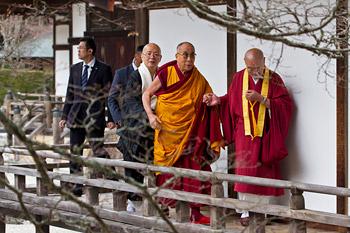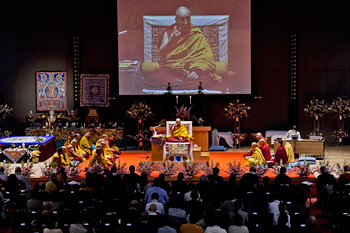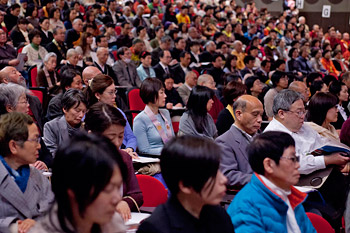Koyasan, Japan, 13 April 2014 - Skies were grey and there was a chill in the air this morning as His Holiness the Dalai Lama left Kyoto to drive to Koyasan. The Koyasan mountains south of Osaka are the headquarters of the Shingon sect of Japanese Buddhism, sometimes referred to as Esoteric Buddhism, an epithet for the path of secret mantra. This is what Kobo Daishi, founder of the Shingon tradition, learned and brought back to Japan after travelling to China in the early ninth century CE. One of his motives for making the journey was to learn Sanskrit to better understand Buddhist scriptures and it seems that one of his early teachers was an Indian Pandit called Prajna who had studied at Nalanda. Kobo Daishi founded the Kongobuji Temple at Koyasan in 816 and passed away in 835 at the age of 62. His Holiness has been invited to teach and grant the Mahakarunagarbhodbhava Mandala Initiation.

|
His Holiness the Dalai Lama walking to the residential quarters at the Kongobuji Temple in Koyasan, Japan on April 13, 2014. Photo/Office of Tibet, Japan
|
On arrival, His Holiness was welcomed at the grand main gate and escorted along wooden corridors, past rooms divided by painted wooden and paper screens, through the complex of buildings that make up Kongobuji to his accommodation. After a traditional Japanese lunch he was driven the short distance to the Koyasan University Auditorium where people from many parts of Japan and abroad were waiting for him.
“Abbot of Koyasan, Dharma brothers and sisters, including some from China, I am very happy to be here and to have this opportunity to speak to you,” were His Holiness’s opening words. “I’ve been here twice before and I’ve given the Vairochana Initiation before too. The difference this time is that it’s so cold. The monks who came on ahead told me there was snowfall and it was very cold just last week and I noticed some remaining clumps of unmelted snow on my way here. Perhaps there was snow to make us Tibetans feel at home.”
To set his Buddhist talk in context, he began by explaining the background to religious practice in the world, suggesting that religion started to appear 3-4000 years ago. 2600 years ago Jainism was founded in India, followed shortly afterwards by the foundation of Buddhism. Judaism, Christianity and Islam emerged from the Middle East, while one of the oldest religious traditions, Zoroastrianism originated in Persia. All these traditions promote love and compassion, however, history shows repeated conflict in the name of religion. Sadly, when this occurs it is like medicine being transformed into poison. However, His Holiness says it does not have to be this way, because all the major world religions exist amicably in India where they live and have lived for centuries side by side in peace and harmony. If inter-religious harmony can be achieved in India, he said, it can happen elsewhere too.

|
His Holiness the Dalai Lama speaking during his teaching at Koyasan, Japan on April 13, 2014. Photo/Office of Tibet, Japan
|
He explained that the basis of Buddhism is the Four Noble Truths which the Buddha taught because we don’t want suffering. The cause of suffering is ignorance, but ignorance is eliminated by knowledge. The first turning of the wheel of Dharma dealt with the Four Noble Truths, the Vinaya, monastic discipline, and concentration, and was taught in public. The second turning concerned the Perfection of Wisdom Sutras, of which the Heart Sutra is a brief example. It involves a dialogue between the disciple Shariputra and the Bodhisattva Avalokiteshvara. It was attended by a more select gathering of people whose merit enabled them to see and hear Avalokiteshvara. With the third turning of the wheel of Dharma the Buddha taught about Buddha nature and also about the clear light of the mind.
With his eye on the clock, His Holiness asked if he could teach half an hour longer than announced to be able to finish the text. His question met with a round of applause. He told a story of an elderly lama in Amdo who was invited to teach at a neighbouring monastery but responded that he was too old to travel. His hosts qualified their request, telling him that he didn’t need to teach, coming and giving blessings would suffice. He went and gave a long, thorough and profound teaching ending with the admonition that he was not the kind of man to go here and there just to lay his hands on people, “I teach”, he said.

|
Members of the audience listening to His Holiness the Dalai Lama's teachings at Koyasan, Japan on April 13, 2014. Photo/Office of Tibet, Japan
|
“In 7th century Tibet, the Tang Emperor’s daughter was married to the Tibetan Emperor Songtsen Gampo, who also married a Nepalese princess. Both wives brought statues of the Buddha with them that instigated Tibetan interest in Buddhism. Shantarakshita, one of Nalanda University’s top scholars was invited to Tibet. He was a great philosopher and logician, who also practised tantra and these qualities set the tone for the development of Tibetan Buddhism. Guru Padmasambhava, who was not a monk, overcame obstacles to the Dharma in Tibet. This trio of abbot, adept and king established the outer practice of the Vinaya, the inner practice of a bodhisattva and the secret practice of tantra.
“Later, after Tibet had fragmented in the 9th century a second dissemination of the Dharma gave rise to the Sakya, Kagyu and Gelug traditions, all of which can be traced back to Nalanda. The source of the Nalanda tradition is the work and writings of Indian masters like Nagarjuna, whose texts we continue to memorize word by word today. We, next, examine and study them thoroughly and finally exercise our understanding in debate.”
His Holiness reminded everyone present that when Dharma is concerned it is important that both teacher and students set a good motivation. He said that for the practice to be Buddhist those involved should take refuge in the Buddha, Dharma and Sangha. For it to belong to the Mahayana they should generate the awakening mind of bodhichitta. After a recitation of the Heart Sutra in Japanese, His Holiness led the assembly in reciting the well-known verse for taking refuge and generating the awakening mind. He then read briskly through Tsongkhapa’s ‘Concise Stages of the Path to Enlightenment - the Song of Experience (latria dud on) stopping every so often to clarify a point. At the end he laughed as he told his listeners that he and Tsongkhapa come from the same part of Tibet, Kombi being barely a day’s horse ride from Tauter.
Tomorrow, His Holiness will complete the teaching and bestow the Mahakarunagarbhodbhava Mandala Initiation 